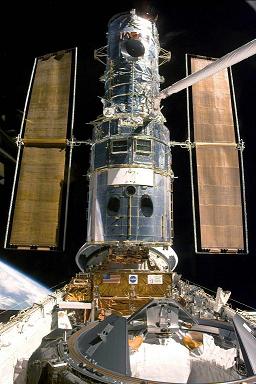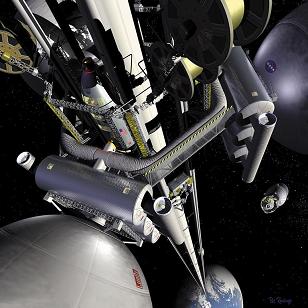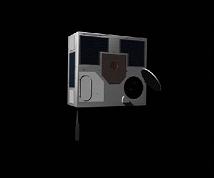Welcome to The OrbitalHub – the place where space exploration, science, and engineering meet. My name is DJ and I will be your host for this week’s Carnival. This is not only my first time participating in the Carnival, but also my first time hosting it. I hope you will enjoy reading this week’s entries.
Stuart Atkinson at the Cumbrian Sky points out that ESA marked a successful and historic day by beginning to involve the public more in their missions. He reminds us about some past missions that ESA was very reluctant to share with the general public.
On October 10, 2008, the Space Shuttle Atlantis will lift off on a fourth service mission to the Hubble Space Telescope. This sky veteran has served astronomers over the past (almost) two decades. On Astronomy at the CCSSC Rosa Williams explains why this mission is important and presents the upgrades that Hubble will undergo.
Space Shuttle flights may end in 2010. Alpha Magnetic Spectrometer, an ambitious cosmic ray experiment, is completed and sitting on the ground without a ride to the Space Station. The AMS mission may coincide with Shuttle retirement. Read The Last Flight at A Babe in the Universe to find out how scientists and the US Congress strongly support an extra mission for AMS. One controversial plan would deliver AMS and retire an Orbiter in space. The AMS mission would be a dramatic end to the Shuttle era.
On Kentucky Space, we can see how The Space Systems Design Studio at Cornell has been studying some superconducting technologies that might enable the building of modular spacecrafts.
Alexander DeClama, on Potentia Tenebras Repellendi, outlines more arguments on why space exploration is justified. Many byproducts of the space industry have migrated into healthcare and other industries over the years, bringing with them increased quality and reliability.
Centauri Dreams, in Cepheid Variables: A Galactic Internet?, looks at a recent paper that speculates on how a super-civilization might be able to modulate the extremely useful (and highly visible) Cepheid variable stars to encode a signal, for broadcast as one type of interstellar beacon. Intriguingly, if such a long-shot scenario turned out to be true, we might actually have data that could confirm it in existing records about Cepheid variables. The authors suggest how we might parse that data, and how future observations could help with such studies.
Ian Musgrave at Astroblog presents an animation of a cloud floating high above the Martian surface. He used Mars Express VMC camera images that ESA has released to the general public for analysis and processing.
Inspired by an article on Centauri Dreams, Music of the Spheres does some virtual space sailing with the help of the Orbiter space flight simulator and a solar sail add-on.
On The Planetary Society Weblog, Emily Lakdawalla covers a hot topic this week in the blogosphere: the encounter of ESA’s Rosetta with asteroid Steins.
David Portree of Altair VI describes the challenges that astronauts must face living and working in microgravity and an ambitious plan for the settlement of Mars in Delivering settlers to Mars (1995). The plan was initially published in the August 1995 issue of the Journal of the British Interplanetary Society by NASA Ames Research Center engineer Gary Allen.
Since the landing on Mars, the Phoenix lander has developed some odd little clumps on one of its legs, leading to speculations about their origin. Read about them on The Meridiani Journal in What is growing on Phoenix?
Even if space is a very harsh environment, it has been demonstrated that the water bears, a sea-monkey-like creature, can survive in the hard vacuum of space. Read all about it on Visual Astronomy in the article that Sean Welton has submitted for this week’s Carnival: Bears in Space?
Any old school astronomy geeks around here? Steinn Sigurdsson presents an illustration of Homeric Epicycles on Dynamics of Cats.
Arthur C. Clarke’s vision of the future seems to be closer to reality as advances are made in separating carbon nanotubes. Read Brian Wang’s post Advance in separating carbon nanotubes brings space elevators a step closer at Next Big Future. This is a significant step towards building a space elevator and towards wider scale use of carbon nanotubes for other applications.
The future in space (and on Earth) of the next 20 years is so bright, you’ll probably need shades… Bruce Cordell of 21st Century Waves explains why in the post Why the World is Not Going to End.
It seems like the LHC (Large Hadron Collider) has an abort button! Thankfully, LHC physicists have a sense of humor about all of this doomsday mumbo-jumbo. Dave Mosher of Space Disco posted a picture of the ‘device’ in The LHC’s Abort Button.
At One Astronomer’s Noise, Nicole Gugliucci tells us about the successful attempt to resolve the super massive black hole at the center of our galaxy. Astronomers used what is called 1.3mm VLBI (Very Long Baseline Interferometry). VLBI is a technique that allows you to create a giant virtual telescope by linking multiple telescopes across long distances.
Measuring the positron emissions of the giant black hole at the center of the universe is quite a challenge. Ethan Siegel, at Starts With A Bang!, presents measurements taken by a detector in the gamma-ray domain and why these measurements are up for debate.
On Cosmic Ray, Ray Villard explores the possibility that the satellites of a Jovian-like planet orbiting around Epsilon Eridani, a star only 10 light-years away from our solar system, could harbor the seeds of life.
David Gamey, from Mang’s Bat Page, posted three articles about MOST (Microvariability and Oscillations of Stars), the suitcase sized microsatellite designed to probe stars and extra solar planets by measuring tiny light variations undetectable from Earth. By using a computer-controlled telescope, an astronomer from Toronto was able to catch MOST on camera. The MOST also started to offer its services to the public: Canadian amateur astronomers can win time on MOST. Even though it is a small telescope, MOST can be used to detect asteroids in an exo planetary system.
If you are an amateur astronomer, Alan Dyer at What’s Up Astronomy can show you how to catch on camera a cosmic flasher. Under the right conditions, the sunlight, reflected by the solar panels of communication satellites, can be observed from Earth.
The Earth is not left out this week. Phil Plait aka The Bad Astronomer, at Bad Astronomy, presents Ten things you don’t know about the Earth. I do not want to spoil the pleasure of reading the post, but I have to mention one of them: there is a measurable effect due to the centrifugal forces caused by the spinning motion of the Earth. The Earth’s diameter measured across the Equator is ~42km bigger than the diameter measured between the poles!
That’s it for this week’s Carnival! Thanks to everyone who submitted an entry. I enjoyed reading all of the posts and getting to know some members of the community. For more details on the Carnival of Space and past editions, you can check out the Carnival page at Universe Today. Many thanks to Fraser Cain at Universe Today for inviting me to host this Carnival.












 Subscribe to our RSS feed
Subscribe to our RSS feed











[…] week the Carnival of Space is being hosted at OrbitalHub. So, go check it out to find a great collection of some of the best space related blog entries of […]
[…] rendezvous is at OrbitalHub, where space exploration, science and engineering meet. Lots of good articles in this week’s edition. Prepare for hypertextual docking in 3..2..1..mark […]
[…] 2008 Some Space Things Posted by catholicsensibility under Astronomy, The Blogosphere The 70th carnival, for starters is hosted at OrbitalHub. Maybe in another week, I’ll get my act together and post something original for […]
[…] OrbitalHub hosts this week’s Carnival of Space. Check out DJ’s first hosting venture. Social BookmarkingTags: Astronomy & Space, […]
[…] for a little bit of space news, don’t forget to check out this week’s Carnival of Space, where you can learn all about whether we can see Dark Matter at the galactic center or […]
[…] II. 21stCenturyWaves.com is again happily participating in the Carnival of Space, this week hosted by OrbitalHub. If you’d like to sample a number of excellent space-related weblogs, please click HERE. […]
[…] 70th Space Carnival (really? Man, that’s a lot!) is online at Orbital Hub. Spend your weekend reading astronomy and space blogs! You know you have nothing better to […]
[…] latest edition of the big space and astronomy blog rodeo and cosmic pot luck dinner known as The Carnival of Space is up over at Orbital Hub. Go read some highlights of the talented astro writers from all over the blogosphere. Perfect […]
[…] of space! I haven’t kept track of this for quiet a time, but I promise I will, K? So, here it is, in a website named Orbital […]
[…] Carvinal of Space #70 at The OrbitalHub. […]
wow this is fantastic this is what the internet is made for, i am abig fan of flight simulator but the space sim is where it really lies “brilliant” keep up the good work
[…] Carnival of Space #70 […]
[…] Carnival of Space #70 dj under Space Exploration  Email This Post […]
[…] Astro Info Week 72 – Twisted Physics Week 71 – Dot Astronomy Week 70 – OrbitalHub Week 69 – Free Space Week 68 – Crowlspace Week 67 – Next Generation Week 66 […]
[…] Astro Info Week 72 – Twisted Physics Week 71 – Dot Astronomy Week 70 – OrbitalHub Week 69 – Free Space Week 68 – Crowlspace Week 67 – Next Generation Week 66 […]
Add A Comment